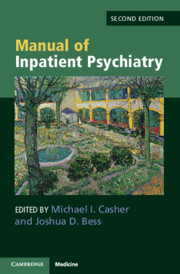Book contents
- Manual of Inpatient Psychiatry
- Manual of Inpatient Psychiatry
- Copyright page
- Contents
- Contributors
- Preface to the Second Edition
- Foreword: American Inpatient Psychiatry in Historical Perspective
- Chapter 1 The Inpatient with Schizophrenia
- Chapter 2 The Inpatient with Depression
- Chapter 3 The Inpatient with Mania
- Chapter 4 The Inpatient with Borderline Personality Disorder
- Chapter 5 The Inpatient with Dementia
- Chapter 6 The Inpatient with Traumatic Brain Injury
- Chapter 7 The Inpatient with Dual Diagnosis (Co-Occurring Disorder)
- Chapter 8 The Young Adult on the Inpatient Unit
- Chapter 9 Clinical Documentation on the Inpatient Unit
- Index
- References
Chapter 8 - The Young Adult on the Inpatient Unit
Published online by Cambridge University Press: 05 March 2020
- Manual of Inpatient Psychiatry
- Manual of Inpatient Psychiatry
- Copyright page
- Contents
- Contributors
- Preface to the Second Edition
- Foreword: American Inpatient Psychiatry in Historical Perspective
- Chapter 1 The Inpatient with Schizophrenia
- Chapter 2 The Inpatient with Depression
- Chapter 3 The Inpatient with Mania
- Chapter 4 The Inpatient with Borderline Personality Disorder
- Chapter 5 The Inpatient with Dementia
- Chapter 6 The Inpatient with Traumatic Brain Injury
- Chapter 7 The Inpatient with Dual Diagnosis (Co-Occurring Disorder)
- Chapter 8 The Young Adult on the Inpatient Unit
- Chapter 9 Clinical Documentation on the Inpatient Unit
- Index
- References
Summary
In the psychiatric literature, “young adults” are often defined by age alone, generally between 18 and 25 years of age. However, a more fluid conception would allow for individual variations in rates of emotional/cognitive development, and would factor in the influence of societal and cultural forces that may delay independent adult functioning [1]. The heterogeneity of young adulthood is not hard to see; most clinicians have encountered 17-year-olds who act and think like they are 21, and vice versa. From the legal standpoint, in most Western cultures 18 is the age of majority, at which point entrance into contractual agreements is allowed and adult responsibility for criminal behavior is demanded. Yet, brain maturation continues at least into the early twenties [2, 3], including ongoing myelination, dendritic arborization, and pruning that lead to increased executive functioning and greater frontal lobe control over limbic emotional centers [4].
- Type
- Chapter
- Information
- Manual of Inpatient Psychiatry , pp. 162 - 182Publisher: Cambridge University PressPrint publication year: 2020



